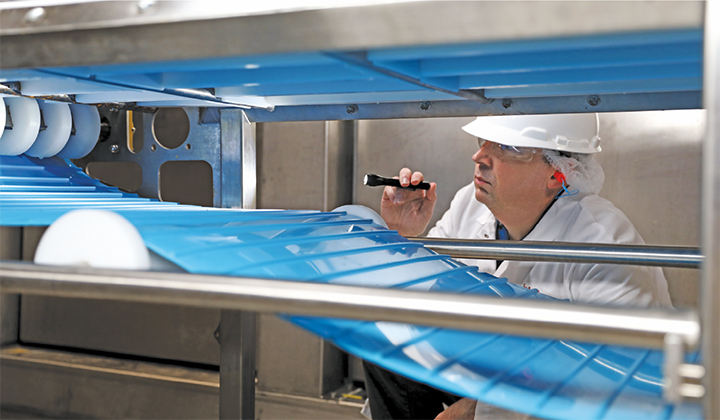
Conveyor systems work under demanding conditions in bakeries. Maintaining them in top shape is the first step to efficiency in production; upgrades will then guarantee optimum performance in handling processes for truly competitive-level manufacturing.
Regular monitoring helps conveyor systems contribute to the performance of the line. A poorly maintained conveyor can experience rapid belt wear and component failure as they operate in either very high or freezing temperatures, or in environments with humidity and dust. This can lead to detrimental downtimes to the productivity of the bakery. If the conveyors of a high-speed production line experience downtimes, the operator must first check whether the first-level maintenance is well performed. This includes cleaning the assemblies and checking the tightening of the assemblies (mechanical sets), lists François Retailleau, Line Product Manager at Mecatherm. The periodic implementation of specific control points on equipment is the second step; according to the specialist, this should include:
+ The correct tension of the chains and belts to reduce premature wear of the elements of the kinematics. If the chains are relaxed, the operator will have to remove links.
+ The examination of the chain lubrication, for metal chain conveyors: a lack of oil can lead to untimely conveyor stops. The last points to check are the lubrication of shaft bearings and the condition of engines.
+ In addition to these mechanical adjustments, the user will have to control the flow of the supports (automatism control). These settings affect the management of slowdowns, shocks, transitions from one machine to another.
+ The operation of detectors and pneumatic elements. A malfunction can cause recurrent downtimes.
Mecatherm also recommends that the operator consults the history of alarms on the HMIs, as they provide an operational overview of the process in real-time and allow the state of the engines and some other parameters of the production line to be controlled.
Finally, downtimes can be minimized by adding retrofit solutions to maintain high-speed production objectives: “If the line is programmed to operate at 300 trays per hour, and the customer wants to upgrade to 400 trays per hour, Mecatherm services can suggest retrofitting and intervene on site to support them,” Retailleau illustrates.
Optimum working settings
A Mecatherm conveying system should operate within several parameters, including the cadence and product capacity of the line. As it links all equipment, it must also be easily integrated within the production line. In addition, “The conveying system contributes to maintaining the cadence of the line, as much as the line equipment does. The feeding speed of the conveyors follows the flow of the line. The higher the cadence, the more important the speed of the conveying system. That’s why it’s a consideration in industrial performance and contributes to the efficiency of continuous line processes,” explains Retailleau.
The conveyors also play an important role in the process: maintaining products aligned on trays from the depositing until the demolding. Missing this mark during transport can lead to sub-standard products in product shape. “From the industrial performance point of view, if the conveyor is smartly designed, it’s possible to adapt and implement solutions in a fairly compact area,” Mecatherm’s specialist adds, listing among solutions: modular conveyors, adaptable in length, width, height, even overhead or superimposed conveyors.
Mecatherm’s MECAFLEX conveying system is designed for flexibility, to allow handling of different types of goods, from raw frozen, pre-pressed frozen, to fresh-baked or frozen. It also supports variety in ranges conveyed at the same time: “The Mecaflex line can produce brioche, baguettes, tin bread, croissants, buns, etc,” lists the specialist.
For real-time product traceability, Mecatherm also develops digital solutions such as the M-Plan, an application that helps visualize the products going through the line, their progress, and helps to manage changeovers and optimize production planning. Combined with M-Plan to anticipate production scenarios, the entire line is designed to ensure continuous production with a modular conveying system, turnouts to route trays in several directions.



